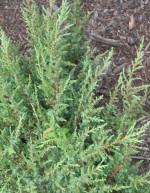 Common juniper is native to more places than any other woody plant and has a variable form to match the diverse areas it calls home. Depending on the geographic origin as well as the cultivar, this fine to medium-textured evergreen shrub or small tree can be prostrate or upright and anywhere from six inches to ten feet tall. The spiny foliage is typically dull grey-green to blue-green in summer but may take on a brownish to purplish tinge in winter that some people consider unattractive. Male and female cones are produced on separate trees with female cones developing blue-black berries with a waxy bloom. The berries take 2-3 seasons to ripen and are used to flavor gin. The bark is shredding and can be attractive but is usually hidden from view by the foliage. Common juniper can be transplanted when young, is easy to grow, and does well even on poor windy sites. Depending on the cultivar, it is useful as a hedge, massed, or as a ground cover.
Common juniper is native to more places than any other woody plant and has a variable form to match the diverse areas it calls home. Depending on the geographic origin as well as the cultivar, this fine to medium-textured evergreen shrub or small tree can be prostrate or upright and anywhere from six inches to ten feet tall. The spiny foliage is typically dull grey-green to blue-green in summer but may take on a brownish to purplish tinge in winter that some people consider unattractive. Male and female cones are produced on separate trees with female cones developing blue-black berries with a waxy bloom. The berries take 2-3 seasons to ripen and are used to flavor gin. The bark is shredding and can be attractive but is usually hidden from view by the foliage. Common juniper can be transplanted when young, is easy to grow, and does well even on poor windy sites. Depending on the cultivar, it is useful as a hedge, massed, or as a ground cover.
Type: Evergreen shrub or small tree
Outstanding Features: Adaptable; evergreen
Form: Upright to prostrate
Growth Rate: Slow
Bloom: Male and female cones produced on different plants; blue-black berries with waxy bloom ripening in 2-3 seasons
Size: Species 5-10’ H x 8-12’ W (various with geographic origin); cultivars as low as 6”.
Light: Full sun
Soil: Average to poor, dry-moist, well-drained; pH adaptable
Hardiness: Zones 3-7 but variable with origin and cultivar; less heat tolerant than other junipers
Care: Low Maintenance
Pests and Diseases: Susceptible to juniper blights, mites and bagworms.
Propagation: Seed; cuttings for cultivars
Outstanding Selections:
-
‘Blueberry Delight’ (1’ tall x 5’ wide; very hardy)
‘Pencil Point’ (columnar, 5” tall x 10” wide)
‘Pendula’ (weeping)
‘Gold Cone’ (columnar; gold in spring fading to bluish green in winter).
